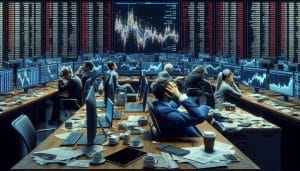As we approach 2024, investors and market watchers are eagerly anticipating the future of silver prices. This precious metal has always been a subject of interest, not just for its industrial applications but also as a store of value. With economic uncertainties and shifting global dynamics, understanding expert predictions becomes crucial for informed decision-making.
FintechZoom, a leading financial technology news platform, has gathered insights from top analysts and industry experts to provide you with a comprehensive outlook on silver prices for 2024. These predictions consider various factors, including economic indicators, geopolitical events, and technological advancements that could impact the silver market.
Key Takeaways
- FintechZoom experts predict silver prices to reach $28-$32 per ounce by the end of 2024, driven by industrial demand and economic factors.
- Increased adoption of renewable energy technologies and electric vehicles is expected to boost silver consumption in 2024.
- Global economic conditions, including inflation rates and currency fluctuations, will play a crucial role in shaping silver prices.
- Geopolitical events and trade tensions can cause rapid fluctuations in silver prices, affecting both supply and demand.
- Investors should consider diversifying portfolios with silver assets and monitor industrial demand projections for potential opportunities.
Understanding the Current Silver Market
The silver market is influenced by a complex interplay of economic, industrial, and investment factors. To grasp the potential trajectory of silver prices in 2024, it’s crucial to examine the key drivers and recent price trends shaping the market.
Key Factors Influencing Silver Prices
Industrial demand plays a significant role in silver pricing. The metal’s unique properties make it essential in electronics, solar panels, and medical applications. Economic growth in these sectors often correlates with increased silver demand.
Global economic conditions impact silver prices. Interest rates, inflation, and currency fluctuations affect investor sentiment and purchasing power, influencing silver’s attractiveness as an investment.
Supply dynamics also shape the market. Mining production, recycling rates, and above-ground stockpiles contribute to the overall silver supply, affecting price equilibrium.
Geopolitical events and trade policies can cause sudden shifts in silver prices. Tensions between major economies or changes in trade agreements often lead to market volatility.
Investment demand, particularly through exchange-traded funds (ETFs) and physical bullion, can drive significant price movements. Investor perception of silver as a safe-haven asset during economic uncertainty can boost prices.
Recent Silver Price Trends
Silver prices have exhibited volatility in recent years. In 2020, the price surged to multi-year highs due to economic uncertainty and increased industrial demand. However, prices subsequently moderated as global economic conditions stabilized.
The ratio between gold and silver prices remains a key indicator for investors. Historically, when this ratio is high, it suggests silver may be undervalued relative to gold, potentially signaling a buying opportunity.
Technical analysis reveals silver prices have formed several key support and resistance levels. These price points often act as psychological barriers, influencing short-term trading patterns.
Seasonal patterns in silver prices show tendencies for stronger performance during certain months, typically aligning with industrial demand cycles and investment trends.
The increasing focus on renewable energy and electric vehicles has bolstered silver’s industrial outlook. As these sectors grow, they’re expected to contribute to sustained demand for silver.
FintechZoom Experts’ Silver Price Predictions for 2024
FintechZoom’s panel of experts offers diverse predictions for silver prices in 2024, reflecting the complex factors influencing the precious metal market. Their forecasts range from bullish outlooks based on industrial demand to more cautious projections considering potential economic challenges.
Bullish Forecasts and Supporting Factors
FintechZoom analysts predict a potential silver price range of $28 to $32 per ounce by the end of 2024. This optimistic outlook stems from several key factors:
- Increased industrial demand: The growing adoption of renewable energy technologies and electric vehicles drives silver consumption.
- Supply constraints: Ongoing mining disruptions and reduced exploration activities limit silver production.
- Investment demand: Rising inflation concerns and economic uncertainties boost silver’s appeal as a safe-haven asset.
- Green energy initiatives: Government policies promoting clean energy solutions increase silver’s industrial applications.
- Weakening US dollar: A potential decline in the dollar’s strength enhances silver’s attractiveness to international investors.
- Economic slowdown: A global recession could dampen industrial demand for silver.
- Interest rate hikes: Central banks’ monetary tightening policies may reduce silver’s appeal as a non-yielding asset.
- Technological advancements: Innovations in manufacturing processes could lead to reduced silver consumption in certain industries.
- Geopolitical stability: Easing tensions in key regions might decrease safe-haven demand for precious metals.
- Strengthening cryptocurrency market: Increased investor interest in digital assets could divert funds from traditional safe-haven investments like silver.
Key Drivers Shaping Silver Price Predictions
Several interconnected factors influence silver price predictions for 2024. These drivers span economic, industrial, and investment domains, collectively shaping the metal’s market dynamics.
Global Economic Conditions
Global economic conditions play a pivotal role in silver price forecasts. Economic growth rates, inflation levels, and currency fluctuations directly impact silver’s value. A weakening US dollar typically boosts silver prices, as it becomes more affordable for investors using other currencies. Interest rate decisions by central banks also affect silver prices, with lower rates often leading to increased precious metal investments.
Industrial Demand for Silver
Industrial demand significantly influences silver price predictions. The metal’s unique properties make it essential in various sectors:
- Renewable energy: Solar panel production requires substantial amounts of silver
- Electric vehicles: Silver is used in electrical contacts and battery technology
- Electronics: Smartphones, tablets, and other devices incorporate silver components
- Medical applications: Silver’s antimicrobial properties make it valuable in healthcare
As these industries expand, particularly with the global push towards green technologies, industrial demand for silver is expected to rise, potentially driving prices upward.
Investment Demand and Market Sentiment
Investment demand and market sentiment are crucial factors in silver price forecasts:
- ETFs and physical bullion: Increased investor interest in silver-backed ETFs and physical silver can drive prices higher
- Safe-haven appeal: During economic uncertainties, investors often turn to precious metals, including silver
- Gold-silver ratio: Traders closely monitor this ratio, with a high ratio potentially indicating silver is undervalued
- Speculative activity: Futures market positioning and trading volumes can cause short-term price fluctuations
Market sentiment, influenced by geopolitical events, economic data releases, and shifts in investor risk appetite, can lead to rapid changes in silver prices. Analyzing these factors helps experts formulate their silver price predictions for 2024.
Potential Impact of Geopolitical Events on Silver Prices
Geopolitical events significantly influence silver prices, often causing rapid fluctuations in the precious metals market. These events can reshape global economic landscapes and investor sentiment, directly affecting silver’s value as both an industrial commodity and a safe-haven asset.
Trade Tensions and Currency Fluctuations
Trade tensions between major economies can dramatically impact silver prices. When trade disputes escalate, they often lead to:
- Increased volatility in currency markets
- Shifts in industrial demand for silver
- Changes in investor risk appetite
For example, ongoing U.S.-China trade tensions have periodically caused silver prices to spike as investors seek safe-haven assets. Currency fluctuations resulting from these disputes can make silver more or less expensive for international buyers, affecting global demand.
In times of economic uncertainty, central banks may implement policies that weaken their domestic currencies. This devaluation can drive investors towards precious metals like silver as a store of value, potentially pushing prices higher.
Political Instability and Economic Sanctions
Political instability in key silver-producing regions can disrupt supply chains and impact global silver prices. Events such as:
- Regime changes
- Civil unrest
- Labor strikes in mining sectors
These factors can lead to supply shortages, driving up silver prices in the short term.
Economic sanctions imposed on countries with significant silver production or consumption can also affect global market dynamics. Sanctions can:
- Restrict the flow of silver to international markets
- Alter trade patterns and industrial demand
- Create uncertainty in pricing and availability
For instance, sanctions on major silver-producing countries like Russia or Mexico could potentially limit global supply, leading to price increases. Conversely, sanctions on countries with high industrial silver demand could reduce consumption, potentially putting downward pressure on prices.
Comparing Silver Price Predictions to Other Precious Metals
Silver price predictions for 2024 are interconnected with forecasts for other precious metals. Understanding these relationships provides a comprehensive view of the precious metals market landscape.
Gold vs. Silver Price Forecasts
Gold and silver prices often move in tandem, but with distinct characteristics. The gold-silver ratio, currently at 83:1, indicates silver’s potential for higher percentage gains. Analysts expect gold to reach $2,100-$2,300 per ounce in 2024, driven by economic uncertainties and central bank policies. Silver’s industrial demand could push its price to $28-$32 per ounce, outpacing gold’s percentage growth.
Key factors influencing both metals:
- Global economic conditions
- Inflation rates
- Currency fluctuations
- Geopolitical tensions
Silver’s additional price drivers:
- Industrial demand in renewable energy
- Electric vehicle production
- 5G technology expansion
Platinum and Palladium Market Outlook
Platinum and palladium markets offer a contrasting perspective to silver’s forecast. Platinum prices are expected to remain stable around $900-$1,000 per ounce in 2024, supported by automotive and jewelry demand. Palladium faces downward pressure, with predictions ranging from $1,000-$1,200 per ounce due to reduced demand from the automotive sector.
Factors affecting platinum and palladium:
- Automotive industry transitions
- Hydrogen fuel cell technology adoption
- Recycling rates of catalytic converters
- Broader industrial applications
- Lower price point for investors
- Potential for higher percentage gains
Strategies for Investors Based on 2024 Silver Price Predictions
Silver’s price outlook for 2024 presents both challenges and opportunities for investors. Implementing strategic approaches tailored to the predicted market conditions can help maximize potential returns.
Long-term Investment Considerations
Diversify your portfolio with silver assets to hedge against economic uncertainties. Consider allocating a portion of your investments to physical silver, silver ETFs, or mining stocks. Monitor industrial demand projections, especially in renewable energy and electric vehicle sectors, as these can significantly impact long-term silver prices. Evaluate the gold-silver ratio periodically to identify potential entry points for silver investments. Stay informed about global economic indicators and geopolitical events that may influence silver’s value over time.
Short-term Trading Opportunities
Capitalize on short-term price fluctuations by closely tracking market sentiment and technical indicators. Use price dips as potential buying opportunities, especially when aligned with positive industrial demand forecasts. Implement stop-loss orders to manage risk in volatile market conditions. Consider using options or futures contracts for short-term silver price speculation. Monitor daily trading volumes and price movements to identify potential breakout or breakdown points. Stay updated on FintechZoom’s silver price analysis and expert predictions to inform your trading decisions.
Conclusion
Silver’s future shines with potential yet remains subject to complex market forces. As you navigate the precious metals landscape in 2024 remember that expert predictions are guides not guarantees. Stay informed about industrial developments economic shifts and global events that could impact silver prices. Whether you’re a long-term investor or short-term trader balancing your strategy with thorough research and risk management is key. Keep an eye on the gold-silver ratio market sentiment and technical indicators to make informed decisions. Ultimately silver’s dual role as an industrial metal and investment asset offers unique opportunities for those ready to delve into this dynamic market.
Frequently Asked Questions
What are the main factors influencing silver prices in 2024?
The main factors influencing silver prices in 2024 include industrial demand, economic conditions, investment trends, the gold-silver price ratio, market sentiment, and speculative activity. Additionally, green energy initiatives, the strength of the US dollar, interest rates, and geopolitical stability play significant roles in determining silver prices.
How does the gold-silver price ratio affect silver prices?
The gold-silver price ratio is a key indicator of silver’s value relative to gold. When the ratio is high, it suggests silver may be undervalued compared to gold, potentially leading to increased demand for silver. Conversely, a low ratio may indicate silver is overvalued, potentially leading to decreased demand and lower prices.
What impact do green energy initiatives have on silver prices?
Green energy initiatives are expected to boost silver prices in 2024 due to increased industrial demand. Silver is a crucial component in solar panels and other renewable energy technologies. As countries invest more in sustainable energy solutions, the demand for silver in these applications is likely to rise, potentially driving up prices.
How do interest rates affect silver prices?
Interest rates can significantly impact silver prices. Generally, when interest rates are low, investors may seek alternative investments like precious metals, including silver. Conversely, higher interest rates can make interest-bearing assets more attractive, potentially reducing demand for silver and lowering its price.
What strategies can investors use for silver investments in 2024?
Investors can consider long-term strategies such as diversifying their portfolios with silver assets and monitoring industrial demand. For short-term trading, tracking market sentiment and using technical indicators can be helpful. It’s important to stay informed about economic conditions, geopolitical events, and industry trends that may affect silver prices.








